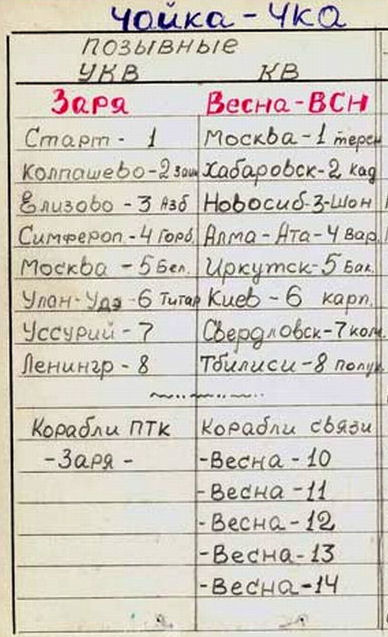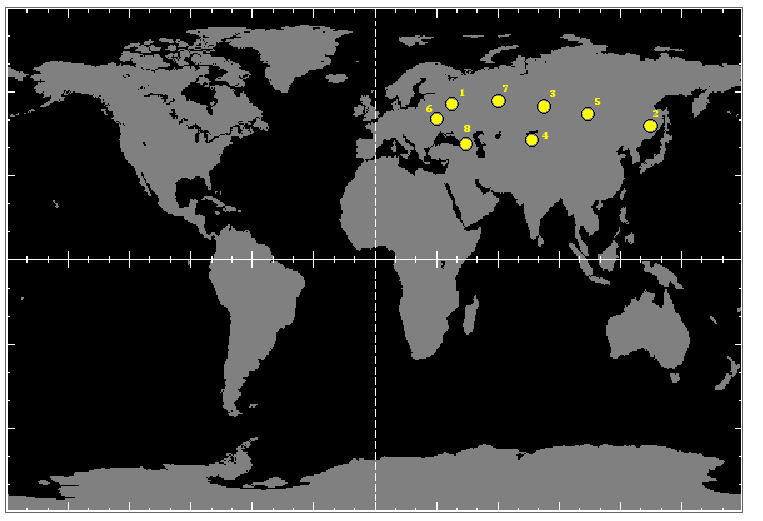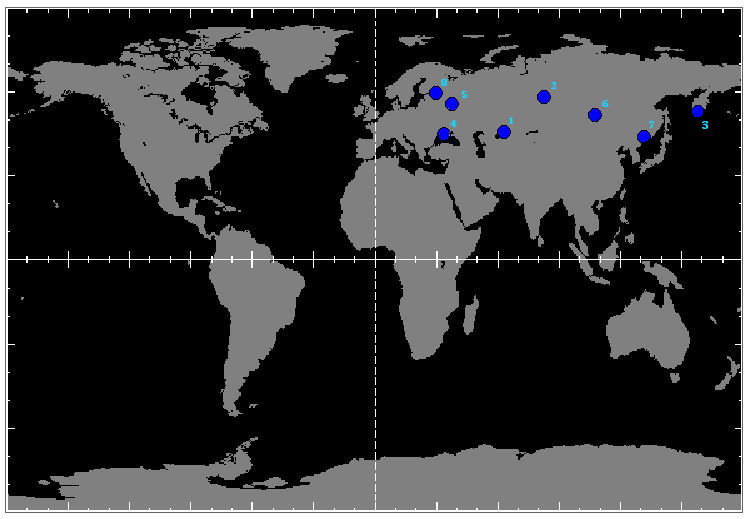
Sven Grahn
The locations of the voice communications stations used during the Vostok and Voskhod have only been known partially until recently (this is written on 8 November 2015). Especially the locations of the shortwave communications stations with "Vjezna" ("Spring") call signs have been only sketchily known. Four of the eight stations names have been known, but only one call sign number. However, a new source has appeared (Thanks, Alexander Dzhuly for making me aware of this) - a page from the log-book of Vostok-6 has been published online (1) - see image below:

The left column lists the the VHF stations with the call sign "Zarya-X" and the right column the "Vjezna" sites. The little notes next to each station reveal the name of the "capsule communicator" at each of the sites. In (1) some of these are explained. The call-sign of Vostok-6, "Chayka" (Seagull) is written in blue. The names are all written in Russian cursive but can be read with relative ease.
The shortwave stations belonged to the Ministry of Communications and were used much during the Vostok and Voskhod flights and were known to have been used during the Soyuz series up to and including the Soyuz 6,7,8 group flight. The last known rception of voice signals on shortwaves from a Soyuz directed at a "Vjezna" ground station was picked up from Soyuz-14 on 5 July 1974 by George Aaron Bailey in Sherwood, Arkansas on 20.008 MHz. On this occasion only "Vjezna" was called, indicating that only one shortwave station may have been operational.
References to Vjezna-1,-4, and -6 were made by Andriyan Nikolayev in his transmissions from Vostok-3 that were intercepted by radio amateurs. Vladimir Komarov called the "Vjezna-2" station from his Voskhod-1 on 13 October 1964. During the flight of Voskhod-2 the station "Vjezna-3" sent instructions in the blind to the crew to use "manual descent".
| Station name | Station location | Capcom |
| Vjezna-1 | Moscow | ? |
| Vjezna-2 | Khabarovsk | Col. Kadushkin |
| Vjezna-3 | Novosibirsk | Cosmonaut Georgi Shonin |
| Vjezna-4 | Alma-Ata | Valentin Varlamov |
| Vjezna-5 | Irkutsk | Vak..? |
| Vjezna-6 | Kiev | Yevgeny Karpov |
| Vjezna-7 | Sverdlovsk | Cosmonaut Vladimir Komarov |
| Vjezna-8 | Tbilisi | - |
In addition there were shortwave stations on tracking ships, Vjezna 10-14. Why Vjezna-9 is missing from the list in the log book is not known. The map below shows the location of Vjezna stations. Varlamov was a cosmonaut from the 1960 group who never flew. Col Kadushkin was not a cosmonaut but belonged to the Air Force. He served at the same station during Gagarin's flight. Military physician Colonel Yevgeny Karpov was the head of the cosmoaut training center from February 24, 1960.

From the transcripts of the voice communications with Yuri Gagarin the identity of Zarya-1 through - 3 has been known. Now we know all stations.
| Station number | Station location | Capcom |
| Zarya-1 | Baikonur | - |
| Zarya-2 | Kolpashevo | Dimitri Zaikin |
| Zarya-3 | Yelizevo | ? |
| Zarya-4 | Simferopol | Cosmonaut Viktor Gorbatko |
| Zarya-5 | Moscow | Cosmonaut Pavel Belyayev |
| Zarya-6 | Ulan-Ude | Lt Col Titarev |
| Zarya-7 | Sverdlovsk | - |
| Zarya-8 | Leningrad | - |
Zaikin was a cosmonaut from the 1960 group who never flew. Lt Col G.Titarev (b. 1918) was not a cosmonaut but belonged to the Air Force. He served as Capcom at the Kolpashevo station during Gagarin's flight.As can be seen in the map below the VHF stations were spread out more in both north-south directions as well as east-west in order to provide maximum line-of-sight coverage. HF stations had over-the-horzon characteristics.

![]()